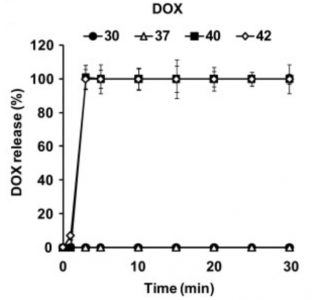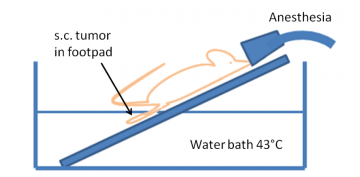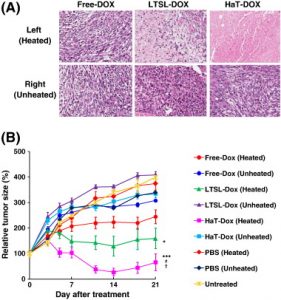Introduction
Thermosensitive liposomes allow for controlled release via releasing its contents locally when a hyperthermic environment is present.

Figure 1. Simplified diagram showing how thermosensitive liposomes will remain stable at body temperature and will undergo burst release at temperatures above 40 degrees Celsius. From Tagami et al. JCR. 2011 Jun; 152(2): 303-309.

Figure 2. HaT (Heat-activated-cytoToxic) liposomes display temperature-dependent drug release. From Tagami et al. Biomaterials. 2011 Sep; 32(27): 6570-6578.
Heat-activated cytoToxic Thermosensitive Liposomes and Enhanced Delivery
HaT is composed of DPPC and Brij78 in a 96:4 molar ratio. Experiments were run using a mouse model which a tumor implanted into the foot and submerged in warm water (Figure 3). Enhanced drug delivery and efficacy was seen with HaT and temperature-driven release was also observed.

Figure 3. EMT-6 cells were implanted subcutaneously into one foot of the mice (left) and then submerged in a water batch at 43 degrees Celsius. The other foot (right) and rectum was kept at lower temperatures. The mice were exposed to this temperature for 1hour post-infusion. Protocol from Tagami et al. JCR. 2011 Jun; 152(2): 303-309.

Figure 4. HaT-doxorubicin liposomes show significant reduction in tumor size (Figure 4B) and appearance (Figure 4A) when heat was applied to treatment area before and after (43 degrees Celsius) compared to free doxorubicin and LTSL-DOX (lyso-lipid temperature sensitive liposomes), another thermosensitive liposome. From Tagami et al. JCR. 2011 Jun; 152(2): 303-309.